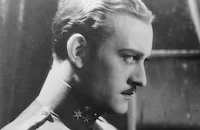The Ship From Shanghai

Brief Synopsis
Cast & Crew
Charles Brabin
Conrad Nagel
Kay Johnson
Carmel Myers
Holmes Herbert
Zeffie Tilbury
Film Details
Technical Specs

Synopsis
Howard Vazey, an American playboy, becomes reacquainted with Dorothy Daley, an English girl, in Shanghai; and joining up with yacht owners Viola and Paul Thorpe, they decide to cross the Pacific to the United States. Ted, a crazed steward, incites the crew to mutiny following a storm that damages the yacht; and assuming the position of captain, he imprisons the socialites. The crew desert the ship when there is a water shortage; Ted induces Dorothy to come to his cabin, where she persuades him that he is insane, causing him to leap overboard and be devoured by sharks.

Director
Charles Brabin
Cast

Conrad Nagel

Kay Johnson

Carmel Myers

Holmes Herbert
Zeffie Tilbury

Louis Wolheim
Ivan Linow
Jack Mcdonald
Crew

Film Details
Technical Specs

Articles
The Ship From Shanghai
By Frank Miller














